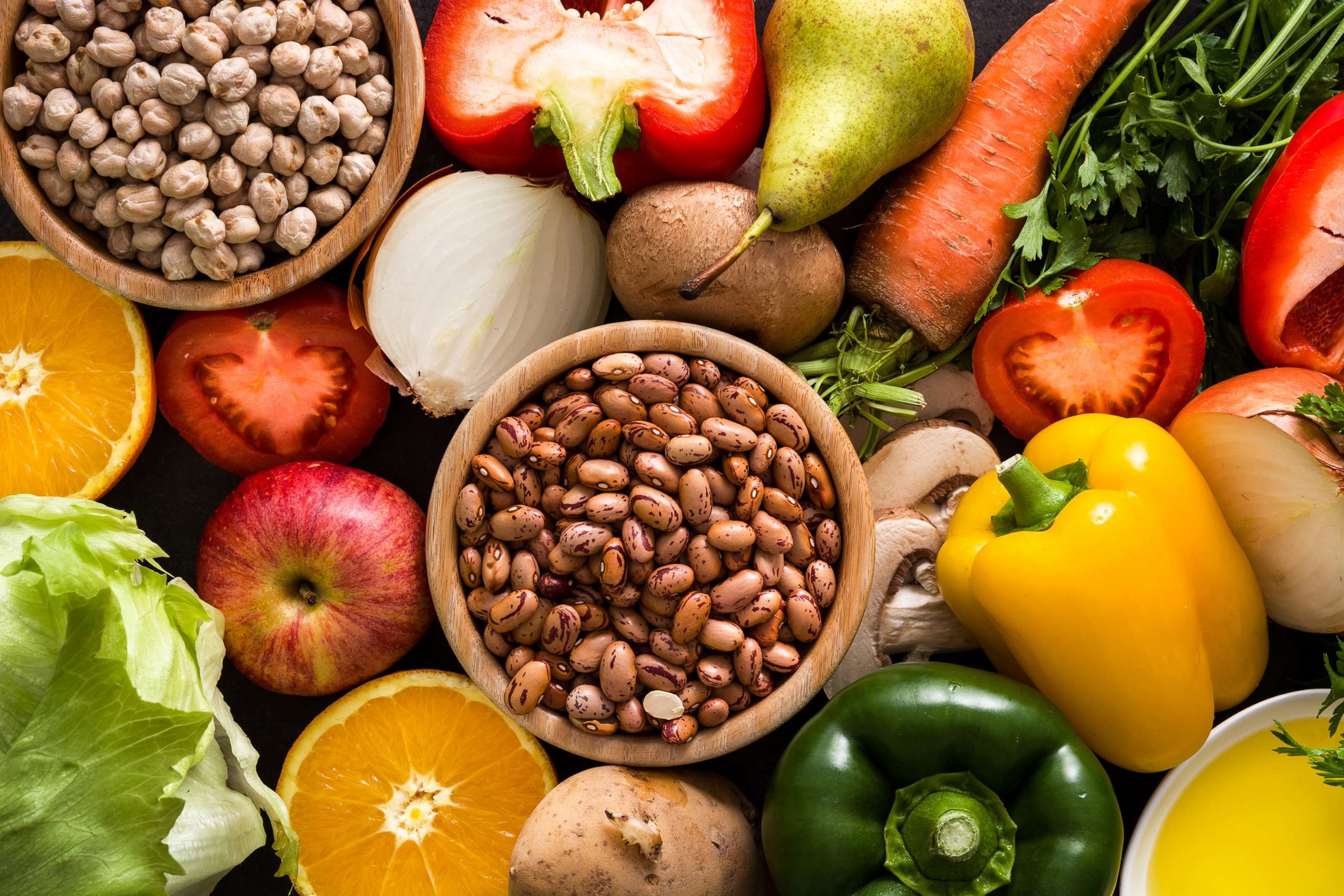Mediterranean diet tops list of best diets for 2020: What to know about the plant-based way of eating
U.S. News and World Report has released its annual list of best and worst diets.
Welcome to GMA’s New Year, Best You. As we ring in the new year, we are sharing everything you need to start the new year strong. From keeping your New Year’s resolutions going to Instagram-worthy meal prep to workout programs to eating plans to taking time for yourself, we have it all covered.
The Mediterranean diet -- a diet heavy on vegetables and whole grains and lean on meat -- is once again at the top of an annual ranking of best diets.
The eating pattern that emulates how people in the Mediterranean region have traditionally eaten, with a focus on foods like olive oil, fish and vegetables, was named best diet overall for 2020 in U.S. News & World Report's annual ranking.
The Mediterranean diet was also named best diet for healthy eating, easiest diet to follow, best diet for diabetes and best plant-based diet.
"Researchers have known for decades that people who live in countries bordering the Mediterranean Sea live longer and suffer less from chronic diseases, which is a big deal," Angela Haupt, managing editor of health at U.S. News & World Report, told "Good Morning America." "The Mediterranean diet is an eating plan, not a structured diet, which means you’re on your own to figure out how many calories you should eat to lose weight and shape it accordingly."
"You’ll emphasize foods like fresh fruits and veggies, whole grains, seafood, legumes and flavorful herbs and spices, while cutting back on red meat, saturated fat and sugar," she said.

Another plant-based diet, the Flexitarian diet, made a big move this year on U.S. News & World Report's list. The diet is ranked number two (tied with DASH) on the best diets overall category for the first time.
"The idea behind the Flexitarian diet is really smart and easy to follow," said Haupt. "Follow a plant-based diet to the greatest extent that you can, but it’s totally fine to have that burger once in a while."
On the opposite end of the best diets list are the Whole30, Atkins and ketogenic diets. Those diets are among the most searched online but rank lowest on U.S. News & World Report's list because of their restrictions, according to Haupt.
"The experts who rate diets for U.S. News say there’s simply no need to cut out entire food groups, such as dairy or whole grains, and doing so could put you at risk of nutritional deficiencies," she said. "It also makes a diet particularly difficult to follow, which lowers the odds of lasting success."
The diets that ranked in the top five of this year's list -- Mediterranean, DASH, Flexitarian, Weight Watchers, Volumetrics, MIND and Mayo Clinic -- have consistently hovered near the top of U.S. News & World Report's rankings for the past several years. Haupt said that should be a big takeaway for consumers.
"The top-performing diets all have some common threads: they’re safe, sensible and based on sound science. You don’t need to wipe out entire food groups or follow lots of complicated rules in order to lose weight and keep it off, and most of the time, it’s better not to," she said. "Eat the foods you’ve always been told to eat, like fruits and veggies and lean protein, and cut back on saturated fat, sugar and red meat, and you’ll likely do OK."
Here is a breakdown of the diets that rounded out the top five in U.S. News and World Report's 2020 Best Diets Overall ranking.
1. Mediterranean diet
The Mediterranean diet is an eating pattern that emulates how people in the Mediterranean region have traditionally eaten, with a focus on foods like olive oil, fish and vegetables.
U.S. News and World Report called the diet a "well-balanced eating plan" and pointed to research that suggests the diet helps prevent some chronic diseases and increases longevity.
The Mediterranean diet emphasizes eating fruits, veggies, whole grains, beans, nuts, legumes, olive oil and flavorful herbs and spices; fish and seafood at least a couple of times a week; and poultry, eggs, cheese and yogurt in moderation, according to U.S. News and World Report.
"Having a glass of wine is just fine, too," said Haupt. "On an average day, you might have smoked salmon for breakfast, or maybe a slice of whole-grain toast with half of a mashed avocado. Lunch could be gazpacho soup or a spiced lentil salad, and then for dinner, perhaps penne pasta with roasted cherry tomatoes, olives, capers and pine nuts."
2. DASH diet
The DASH diet, made up of low-sodium and healthful foods, was originally started by the National Heart, Lung, and Blood Institute (NHLBI) as a diet to help reduce blood pressure.
The NHLBI publishes free guides on the plan so you can see if it is right for you.
The plan focuses on fruit, vegetables, whole grain, lean protein and low-fat dairy and eliminates foods high in fat and sugar-sweetened drinks and sweets, according to U.S. News and World Report.
2. Flexitarian diet
The flexitarian diet encourages people to try alternative meat options, like tofu, but leaves room for flexibility if you can't quite fully give up meat. The diet was promoted by dietitian Dawn Jackson Blatner in a 2009 book that says you can reap the benefits of a plant-heavy diet even if you eat meat occasionally, according to U.S. News and World Report.
This plant-heavy diet focuses on adding five food groups -- "new meat," fruits and vegetables, whole grains, dairy and sugar and spices -- to your diet, instead of taking foods away.
The "new meat" food group includes tofu, beans, lentils, peas, nuts, seeds and eggs, according to U.S. News and World Report.
4. WW
WW, formerly Weight Watchers, ranked in the top five for best diets overall and continued to hold the No. 1 spot for best commercial diets and best weight-loss diets for 2020.
The program, which is backed by Oprah Winfrey and recently signed on Kate Hudson as an ambassador, rebranded in 2018 with a new name, WW, and a focus on wellness.
WW's myWW program, launched late last year, uses details of members' food preferences and lifestyle to match members with one of three ways to follow the WW program, according to the company.
applies points values to foods, with higher points for foods high in saturated fats and sugars, and lower points for foods with high levels of protein.
WW offers its members support online and is well-known for its in-person group meetings.
5. MIND diet
The Mediterranean-DASH Intervention for Neurodegenerative Delay (MIND) diet, ranked fifth last year, is a hybrid of the top-rated DASH and Mediterranean diets.
The diet focuses on "10 brain-healthy food groups: green leafy vegetables in particular, all other vegetables, nuts, berries, beans, whole grains, fish, poultry, olive oil and wine," according to U.S. News and World Report.
Among the diet's requirements is eating three servings of whole grains, a salad and another vegetable daily, as well as a single glass of wine if desired.
5. Volumetrics diet
The Volumetrics diet is described by U.S. News & World Report as "more of an approach to eating" than a structured diet.
Food is divided into four groups with the goal of eating more of categories one and two (fruits and vegetables, nonfat milk and broth-based soup, grains, low-fat meat, legumes) and less of categories three and four (meat, crackers, cheese, cookies, nuts, butter, oil, candies and chips).
"The point is to learn the Volumetrics philosophy and apply it where you can throughout the day," writes U.S. News & World Report. "See where you can replace a category four item (baked white potato) with a category one item (sweet potato), for example."
5. Mayo Clinic diet
The Mayo Clinic diet focuses on a restructured food pyramid that emphasizes fruits, vegetables and whole grains, according to U.S. News & World Report.
"In general, these foods have low energy density, meaning you can eat more but take in fewer calories," writes U.S. News & World Report. "Think of it this way: For about the same amount of calories you could have a quarter of a Snickers bar or about two cups of broccoli."







